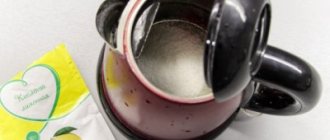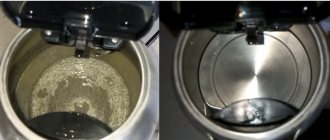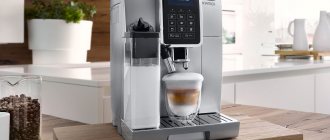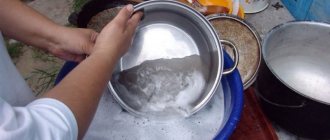What is scale and why must it be removed?
Sometimes on the Internet you can find the opinion that it is not necessary to remove scale - it is a purely visual defect, which plays a role only in glass teapots. This statement is completely wrong.
First of all, you need to understand how scale appears. Most often, ordinary running water is used for boiling, which contains quite a lot of impurities. However, they are found in both bottled and filtered water - albeit in smaller quantities.
Most of them are various salts, which, when heated, are separated into carbon dioxide and a solid sodium precipitate, which remains on the walls of the dish. However, it is not washed off with ordinary water and tends to accumulate.
The problem of scale is not only an unaesthetic appearance
Such deposits harm your kettle: it impairs thermal conductivity, which means it will take more time to heat up. Because of this, in conventional kettles the layer of ceramic coating, if any, gradually becomes thinner, and in electric kettles the heating elements fail faster.
However, this factor can be considered rather secondary. The main reason you should deal with scale is because of the potential health risks. Since plaque consists of sediments of salt, insoluble metals and various harmful impurities, including chlorine, sediment entering the body can contribute to the development of various diseases. The mixture can provoke arthritis, gout, osteochondrosis, kidney stones or toxicological poisoning.
That is why you need to clean the kettle from plaque regularly. In the following sections we will talk about how to do this correctly.
Why is it important to descale regularly?
The appearance of scale is a completely natural process. Magnesium and calcium salts contained in tap water accumulate on the bottom and walls of the kettle. When boiling, the structure of water changes, and as a result, scale appears.
If you accidentally swallow a little plaque, nothing will happen to your body. But regular use (if you wash the kettle of deposits too rarely) can negatively affect internal organs and the condition of blood vessels.
Over time, excess salts will begin to clog blood vessels and accumulate inside the joints. In severe cases, kidney stones may form.
Therefore, you need to try to remove scale when it first appears.
How often should you descale your kettle?
The answer to this question depends on two factors - the type of heating device and the quality of the water you use.
Glass teapots need to be cleaned almost every week: any plaque, even the thinnest one, is noticeable on the transparent surface. But metal or ceramic ones can be cleaned of plaque about once a month - as they become dirty.
In addition, kettles with an open heating coil require cleaning more than those with a closed heating element. Otherwise, the device will fail faster.
As for the quality of water, see for yourself. Bottled or well-filtered water pollutes the kettle less, but it is not a panacea - only distilled water does not produce sediment at all, but we do not recommend anyone to drink it - it is too harmful to health.
The quality of tap water depends on the water supply service, its source, and even the condition of the pipes in your home. Sometimes it is enough to clean the kettle once every couple of months, and sometimes after just a week a thick layer of scale forms in the tank.
Therefore, the decision on the frequency of cleaning your kettle is up to you - it is impossible to give an exact answer remotely.
Let's move on to specific recommendations.
What causes white deposits in the form of scale?
In electrical appliances for heating water, a white coating in the form of solid deposits forms in the places where the water is heated, near the heater.
In enamel cookware, the bottom and inner walls of the vessel are mainly affected.
Deposits appear due to the composition of the water, which contains salts. The amount of salt masses in different water varies and the more there is, the more often your dishes will become dirty.
How to prevent scale formation
You will hardly be able to completely avoid the appearance of precipitation - unless you really use crystal clear water, with a minimum of heavy impurities. However, it is quite possible to reduce the amount of scale.
To do this, follow our recommendations:
- First of all, if the water quality in your home leaves much to be desired, invest in a good water filter. What it will be, cassette or streaming, is up to you. Personally, we recommend the faucet attachment - it is considered the most effective and economical option today.
- Do not leave water in the kettle. After drinking tea, some of the water is not used? Pour it out. This will make caring for the kettle much easier in the future.
- Try to regularly wipe the kettle with a soft sponge soaked in soapy water. If there is no old plaque on the surface, you can remove particles that have not yet adhered, which over time will turn into persistent sediment.
Tip : Even if you don’t have the opportunity to purchase a filter, try to let the water settle before boiling. A day will be enough.
Using these simple recommendations, you can make caring for your kettle easier and prevent the formation of a thick layer of scale.
If it was not possible to completely avoid the appearance of scale or you need to clean the old kettle, we recommend using our recommendations.
To prevent scale from appearing
As you know, it is better to prevent than to deal with the consequences. To prevent severe scale from appearing on the kettle, you need to follow a few simple rules:
- Do not allow scale to accumulate and remove it as soon as a light coating appears. This procedure will need to be done only 1-2 times a month.
- Try not to leave water in the kettle for a long time after use. Rinse the kettle before and after use.
- And it is better, of course, to use filtered or settled water. This will be healthier for both the teapot and your health.
If it does happen that the walls and bottom of the kettle are covered with a thick layer of scale, do not scrape it off with a knife or other metal objects. This can seriously damage the dishes. Use one or more of the above methods and choose the best way to clean your kettle.
Method 1: Clean the kettle with citric acid
A banal food product that costs a couple of rubles, which can be found in any kitchen, can easily cope with mild to moderate scale. The procedure is not particularly complicated: fill the kettle two-thirds with water and add citric acid. The powder should be poured at the rate of one tablespoon for every liter of water.
Citric acid is one of the most affordable ways to descale a kettle
Then turn on the kettle and wait until the water cools down. Drain the water when it has cooled to room temperature. Then wipe the kettle with a soft sponge. If necessary, the procedure can be repeated two or three times in a row until the scale is completely gone. After this, boil the kettle again with clean water and wash it thoroughly.
The method is effective, but it will not cope with old scale that has ingrained itself into the surface. In addition, it is not suitable for enamel teapots - the surface of the latter may become dull from the aggressive effects of citric acid. But it can be used for both conventional and electric kettles.
Conclusions : Effective, budget-friendly and very simple method.
Store products
You can get rid of scale in your kettle using professional cleaners. They are available for sale in retail stores and online markets. Popular and effective means:
- Topperr for descaling electric kettles. The amount of solution per 1 liter of water is 100-120 ml. Heating temperature – 50 degrees. Exposure time – 30 minutes. Price – 145 rubles for 250 ml.
- Top House descaling cleaner for teapots and coffee makers. The amount of solution per 1 liter of water is 150-200 ml. Heating temperature: bring to a boil. Exposure time – 30 minutes. Price – 275 rubles per 500 ml.
- Mellerud for quick descaling. The amount of solution per 250 ml of water is 60 ml. Heating temperature – to boiling. Exposure time – 15 minutes. Price – 500 rubles per 500 ml.
- Antiscale : descaling agent. The amount of powder per 1.5 liters of water is 1 tablespoon. Heating temperature – to boiling. Exposure time is 20 minutes. Price for 100 g – 13 rubles.
- Cillit for descaling. The amount of solution per 500 ml of water is 100 ml. No heating required. Exposure time – 30 minutes. The price for 450 ml of solution is 195 rubles.
All of the listed compositions are highly effective, so you can choose a product that will not burden the family budget.
Method 2: Clean the kettle with lemon
For those who prefer to use the most natural products in the kitchen, citric acid can be replaced with lemon. As with the previous method, you should not experiment with enamel teapots unless you want the enamel to discolor or crack.
Cut the lemon into thin slices and place in a kettle filled two-thirds with cold water. Then boil it. Further, the procedure differs for conventional and electric kettles.
The most environmentally friendly way to clean a kettle
In the first case, you need to wait for the water to boil, and then keep the kettle on low heat for 20-30 minutes.
For an electric kettle, you need to boil it several times, after the water has cooled a little - on average, reviews recommend three boils with an interval of 10 minutes.
After the water has cooled completely, drain it and wipe the kettle with a soft sponge to remove any remaining deposits. Most often, a repeat procedure is not required, but if necessary, you can boil the lemon again. Bonus - a pleasant aroma that will spread throughout your kitchen.
Sweet clear soda
Carbonated drinks help to effectively cope with even persistent limescale deposits. The drink should be poured into the kettle, then left for 2-30 minutes until all gases come out and boil the liquid in the device. It is not recommended to use colored soda: orange or brown drinks can severely stain the plastic parts of the kettle.
antiscale
Method 3: Clean the kettle with vinegar
First of all, it should be noted that this technique is not suitable for electric kettles: vinegar can only be used for ordinary metal ones. However, for them this method is very effective and convenient.
As in previous cases, you need to fill the kettle two-thirds full. Add vinegar, about half a glass per liter. If you are using concentrated essence, you will need one and a half tablespoons for the same amount of liquid.
Measure the amount of vinegar carefully
Boil water and leave to cool for one hour. Then simply drain. Use a soft sponge to wipe stubborn stains and they will come off. After cleaning, you need to boil the kettle with plain water two or three times.
Important : Please note that vinegar emits a very strong aroma when heated, so you should only carry out the procedure with the windows open or a powerful hood turned on.
Why does plaque appear?
Tap water supplied to private and apartment buildings contains too many salts. When boiled, they precipitate and form a dense white coating.
In conventional kettles, it settles on the inner walls and bottom; in electric kettles, scale covers the heating element.
Specially installed filters do not solve this problem. They help reduce the smell of bleach and purify water from heavy metal impurities, but this does not make it softer.
There are several arguments that indicate the need to periodically remove scale:
- plaque contributes to premature failure of electric kettles;
- the water acquires an unpleasant aftertaste;
- Some of the scale enters the body, which has a bad effect on health and is especially dangerous for people with diseases of the digestive system.
Attention! To maintain the device in excellent condition, you will need to remove plaque regularly, once every two to three weeks.
Method 4: Clean the kettle with soda
An inexpensive and healthy way to get rid of even the oldest and hardest scale is to use baking soda. It is suitable for all types of teapots, including enameled ones.
It is important not to overexpose the soda in the kettle
However, you should use baking soda carefully - it can scratch the surface, so don't try to just wipe off the plaque with it. In addition, in order to get rid of the old layer of scale, you will have to repeat the procedure at least three times.
Add one tablespoon of soda to half a kettle of water (no more!). For a regular kettle, boil the water for half an hour. For electric, you need to turn on the boiling mode several times. Forum users claim that three to four times are enough.
Preventing scale formation
Of course, this problem cannot be completely avoided; scale will form again and again. But you can reduce the number of procedures to remove it to a minimum if you follow simple recommendations:
- Use filtered water. If there is no filter, buy a bottled one. In any case, water straight from the tap is not advisable, especially if it is hard.
- Do not boil the same water several times. Pour it into a jug, and after each boiling, rinse the kettle with water.
- Do not allow scale to accumulate, do preventative cleaning.
Method 5: A mixture of vinegar and soda for cleaning teapots
As everyone knows, when soda is added to vinegar, a chemical reaction occurs. You can use it to clean scale from a kettle, but you should be careful - you can’t just fill the kettle with vinegar and add baking soda. Such an aggressive impact will damage the container.
When mixed, baking soda and vinegar produce an active chemical reaction.
You need to fill the kettle two-thirds full and add one tablespoon of baking soda per liter of water. Then pour half a glass of vinegar into the tank or add three tablespoons of vinegar essence.
Bring the water to a boil and keep the kettle on low heat for half an hour. Then use a soft cloth to wipe off any dirt. This method is not suitable for electric kettles, but it does an excellent job of cleaning old scale from regular ones.
Tools that are always at hand
This article provides ways to clean a kettle at home. Tools that can be found in almost any kitchen will come to the rescue. After all, these products are used for cooking.
Due to the content of certain organic acids in them, these products are effective means for combating limescale in a kettle.
Every housewife definitely has baking soda and vinegar. For an improved effect, use calcined. Citric acid or fresh lemons are also an excellent remedy for solving such problems. And even apple peels or potato peelings will come in handy in this matter.
And a good housewife will certainly have several canned jars of tomatoes or cucumbers. Their brine does not need to be poured out.
Brine does an excellent job of removing scale from teapots due to its acetic acid content. Another very effective remedy is sweet carbonated drinks.
Let's consider which product is best suited for each type of kettle. But no matter what method you choose, it’s worth remembering one main rule: after cleaning, the kettle needs to be filled with water again, boiled, and then poured out. Thanks to this procedure, you can get rid of small particles of scale and cleaning agent residues.
Method 6: Remove old scale with soda, vinegar and citric acid
This method cannot be called gentle: it has a very aggressive effect on the surface, so it is permissible to use it only if the kettle has not been cleaned for several months and a thick layer of scale has formed inside.
This method is only suitable for the oldest scale
In order to clean the kettle, you will need to boil water in it three times for 30 minutes. The first time - with a tablespoon of soda, the second time - with a tablespoon of citric acid, the third time - with half a glass of vinegar. For each case, water should fill the container by two-thirds.
After the last boil, carefully wipe the kettle with a sponge and then boil it several times with clean water. It is very important to ventilate the room well during the cleaning process, as vinegar emits an extremely unpleasant odor when heated.
Fighting scale with improvised means
First, let's discuss how this can be done using available tools. But first, evaluate the condition of your kettle - what material it is made of. An electric and a regular kettle also require a different approach.
The easiest and safest way to remove scale is citric acid. It breaks down solid deposits and turns them into easily soluble and washable elements. This method is universal; it is suitable for enamel, metal and electric cookware. It is safe and not harmful to humans. The lemon itself, lemon juice, and zest are suitable for cleaning. You will need water (preferably filtered) and two lemons. So let's get started:
- Rinse the lemons thoroughly and pour boiling water over them.
- Roll the citrus fruit several times on a clean, flat surface. This will also help the juice release.
- Cut the lemon into slices or slices.
- Pour filtered water into the kettle.
- Send the sliced lemon there along with the juice that was released during slicing.
- Bring the water to a boil.
- Leave the water in the kettle until it cools.
- Remove the water along with the lemon.
- Treat any remaining limescale with used lemon.
- Wipe the walls and bottom of the kettle with a soft cloth without using hard sponges or abrasives.
- Rinse the kettle.
Considering the cost of citrus fruits, this method of dealing with scale may not seem economical. Then we will use citric acid.
For the procedure, one spoon of citric acid is enough - the bag will last for a long time.
- Pour a spoonful of citric acid into the kettle, pour in 500 milliliters of water, and boil.
- After 20-30 seconds, repeat boiling.
- After boiling, do not drain the water for 1.5 hours.
- Then pour out the water and remove any remaining plaque.
- If necessary, repeat the procedure.
- After completely removing the sediment, pour clean water into the kettle and boil
- Drain the water and rinse the kettle.
You can do without boiling, but this measure is more likely to be preventive, or if the scale is not large. To do this you need:
- Pour citric acid into a kettle with warm boiled water.
- Stir and leave the solution for at least 5 hours (it is best to do this in the evening, until the morning).
- Pour out the liquid and rinse the kettle with clean water.
- Fill it to the maximum mark and boil.
- Drain this water.
- You can use it.
If the kettle is electric or metal, then you can use table vinegar.
It certainly exists in every home. However, this is a very aggressive method, so it should not be used often. In addition, vinegar is very volatile, so the smell during the procedure is not guaranteed. And yet:
- In a kettle filled with water to the maximum level. Add 5 tablespoons of 9% vinegar.
- Boil, wait 15 minutes and boil again.
- Rinse the kettle thoroughly using special products to get rid of the pungent odor.
- Boil clean water in a kettle 3-4 times
Please note that plastic teapots cannot be cleaned this way.
Baking soda, or sodium bicarbonate , is a completely universal substance and an ideal household helper. And soda does a great job of removing scale. Because:
- Softens hard deposits, making them easy to remove.
- Destroys harmful bacteria.
- Has a slight abrasive effect and does not damage surfaces.
- Safe for humans.
To remove limescale, just boil water in a kettle with the addition of 1 spoon of this substance. Let the water cool, pour it out and remove any remaining scale with a sponge or cloth.
Do you like Coca-Cola?
But there is no scale, so we use this carbonated drink in our fight. True, it is better to release excess gases before starting. Next we proceed as follows:
- Fill the kettle halfway with Cola.
- Boil it and leave for at least half an hour.
- Drain and wipe the insides of the kettle with a dishcloth.
- Rinse with clean water.
- Fill the kettle with water to the maximum and boil.
- The kettle is ready to use.
If the scale in the kettle is very strong and thick, proceed as follows:
- Boil water in a kettle, filling it 3/4 full.
- Pour 3 tablespoons of soda into boiling water and leave for half an hour.
- When the water starts to cool, turn on the kettle or put it on gas and boil.
- Pour out the solution, rinse the kettle with warm water and rub the walls with a sponge.
- Fill the kettle halfway again and add 1 tablespoon of vinegar essence.
- Boil and leave until completely cool.
- Pour out the solution and scrub the inside of the kettle well with a hard sponge.
- Boil again with clean water.
This procedure may need to be repeated several times.
Method 7: How to clean a kettle with Cola, Sprite or Fanta?
Oddly enough, however, this method has a right to exist.
First of all, a few rules:
- Do not use this method for electric kettles with an open heating coil - the sugar contained in drinks will cause much more damage to it than scale.
- For enameled surfaces, choose drinks without dyes, otherwise the shade of the container may change in a completely unpredictable direction.
- If there are scratches inside the kettle, you should also abandon this method - the dyes may become embedded in the damaged surface.
The cleaning process itself is quite simple. Fill the kettle halfway with the drink and turn it on. Leave it for about 20 minutes after the liquid boils. Drain it and rinse it with clean water.
Cola is not only a drink, but also an excellent cleaning agent
It sounds incredible, but even old scale can be cleaned this way. However, another question arises here - how safe it is to drink such drinks if they remove something that aggressive detergents cannot always cope with.
What not to use when cleaning
To descale your kettle without damaging it, do not use:
- hard metal brushes, knives;
- abrasive cleaners that will scratch walls and heating elements;
- chemical acids (hydrochloric, sulfuric), caustic soda;
- substances containing chlorine;
- washing powder.
Method 8: How to clean a teapot with apple peelings.
Another method from the “Incredible but true” category. It doesn’t always work: if the scale is old, you won’t be able to get rid of it this way. But with plaque that has just appeared, the method works perfectly. In addition, it is considered one of the most gentle. It can be used for glass teapots - it is both environmentally friendly and will help give them shine.
The method is suitable for savings fans: no waste!
Simply boil two handfuls of apple peels in half a kettle of water for 20 minutes. For electric kettles, you can turn on the boiling mode 2-3 times. Then leave the device for two hours. After this, you can drain the liquid and wipe the inside of the kettle with a soft cloth. Rinse it well - the clean kettle is ready for use!
Additional recommendations
Please note that special descalers are more harmful to human health than homemade ones. They contain chemicals that cause allergies, poisoning, and poor health. Therefore, carefully remove any remaining household chemicals by rinsing. Better yet, boil the kettle 2-3 times, changing the water each time.
To safely descale your kettle, leave it in an inaccessible place. To avoid trouble, warn family members not to drink water from it until the procedure is completed.
Unplug the electric kettle from the socket while rinsing. Protect your hands with rubber gloves. Use soft sponges, a cloth, or an unnecessary toothbrush for hard-to-reach places.
Method 9: Use brine to clean teapots
Frankly speaking, this method is not for everyone. It's hard to imagine a person who likes the smell of boiling brine. However, if you are not sensitive to fragrances and the naturalness of the product is important to you, you can experiment.
It is necessary to pour the brine into the kettle, boil and leave for half an hour. Then drain the brine and rinse the kettle with clean water.
Not everyone will like boiling brine.
True, not every brine is suitable - only one that contains vinegar or citric acid. It is through their action that the effect is achieved. But here the question arises: why boil the brine if you can just use acid or vinegar?
Features when cleaning different types of kettles
To avoid scratching the walls, do not use mechanical methods of cleaning the kettle: hard scrapers, brushes, brushes. Moreover, it is long and tedious.
Give preference to an effective, inexpensive chemical method for descaling a kettle based on cleaning substances and mixtures, using the table:
| Type of teapot | Allowed methods | Prohibited methods |
| Aluminum non-electric | Soda, peels of apples, pears, potatoes, household chemical mixtures. | Citric and acetic acid, canning brines, carbonated drinks. They will leave indelible stains inside. |
| Non-electric stainless steel | Vinegar, citric acid or a combination of both. Laundry soap, soda, brine, potato and apple peels, oxalic acid, household chemicals. | Caustic industrial acids. |
| Enameled non-electric | Soda, apple skins, potato skins, colorless carbonated drinks, approved household chemicals. | Brine, citric acid, soda with vinegar or citric acid. Colored carbonated drinks can stain enamel. |
| Plastic, ceramic, glass - electric | Citric acid, brine, household chemicals | Vinegar with soda |
| Metal electric | Soda, citric acid, apple and potato peels, household chemicals | Brine, vinegar and soda |
The wrong choice of method for getting rid of lime can lead to zero results, damage to the surface or the entire device.
Method 10: Chemical descaling agents
If quick results are important to you and you don’t want to experiment with your own kettle, you can simply go to a hardware store and buy a descaler.
Antiscale, Cinderella, Shine... There are many options, for every taste and budget. We recommend that you carefully study the composition: some drugs should not be used, as they can have an aggressive effect on the coating of the kettle or cause harm to your health.
If you don't want to experiment with a teapot.
On the other hand, most safe products contain the same citric acid or soda as an active ingredient. So is it worth overpaying?
In any case, you can use any of the methods we have given - depending on the type of kettle you have, of course.
Why you need to get rid of scale in your kettle
The rate at which salt deposits form depends on the quality of the water. The higher the hardness index, the faster the scale settles on the electric heater and the walls of the device.
Maintenance of such equipment must be timely, because:
- rust forms under a layer of limescale, which destroys the metal;
- scale has low thermal conductivity, while blocking the contact of water with the heating element. In order to heat the liquid to the required temperature, the device has to work hard, this reduces its service life;
- under the influence of high temperatures, lime deposits impair the taste of water;
- Over time, excess salts, which inevitably enter the body with water, can have a negative impact on the functioning of the excretory system, kidneys, bones and joints.
Scale can have a negative impact not only on kitchen appliances, but also on the human body
How to quickly remove using special means?
In addition to folk remedies, you can use ready-made household chemicals . It is more expensive, but has a good effect. The release form in most cases involves liquid, gel or tablets.
Top House
Product made in Germany. It goes on sale in two forms: tablets and liquid. Designed for dissolving scale in teapots, coffee makers, coffee machines, as well as on ordinary dishes. The effect is due to the presence of organic acids in high concentrations. Top House has no smell. The bottle cap is made with a child safety feature.
The application algorithm is very simple. Pour a liter of water into the heating container, bring to a boil and turn off the device. After 5-6 minutes, pour 150 ml of cleaner (or 200 ml for thick deposits). Soaking should last 30 minutes. After this, the solution is drained and the container is washed.
When using a tablet product, take one tablet per liter of water (or two if heavily soiled). Further, the course of purification coincides.
The cost of a 500 ml bottle is approximately 250-280 rubles. The price of a package of tablets (8 pieces, 25 grams each) is on average 270 rubles.
Topper
A German-made liquid concentrate is designed to remove limescale in kettles, coffee makers and other water heating devices. Considered universal and environmentally friendly . The formula contains citric acid, surfactants (at least 5%) and auxiliary agents.
To clean, pour a liter of water into the container, then add 100 or 120 ml of Topperr. Heat the liquid to 50 degrees. For the reaction to take place in full, wait another half hour.
After the procedure, the kettle is thoroughly washed and a control portion of water is boiled. The cost of a 250 ml bottle ranges from 150-250 rubles.
Five Plus
The product is from a Russian manufacturer . The liquid is produced using the latest technology using colloidal silver. This ensures not only the removal of limescale, but also the disinfection of heating containers. The composition also includes a mixture of acids and an anti-corrosion additive.
The product does not leave any foreign smell or taste after cleansing, so it is suitable for teapots and coffee makers. The liquid is not used for enamel surfaces.
The manufacturer guarantees cleansing in just one procedure. To do this, pour two parts water and one part Five Plus into the tank. Bring the liquid to a boil, turn it off and leave for another 20-30 minutes.
After this, the solution is drained, the kettle is washed and rinsed twice. A 500 ml bottle can be purchased for 200-250 rubles.
When using ready-made chemicals, you must be careful and wear gloves . If the product comes into contact with the mucous membranes of the eyes, it is necessary to rinse them with plenty of water.
Do Coca-Cola, Sprite and other carbonated drinks work?
One of the main theoretical arguments about the dangers of carbonated drinks is their ability to effectively clean dishes and even plumbing fixtures - sinks, toilets. But is it really possible to descale a kettle with cola?
The recipe looks like this: fill the device with Coca-Cola or Pepsi, bring to a boil, let it cool and pour it out, and treat the kettle with running water so that it does not remain sweet and sticky.
The ability of carbonated drinks to fight scale is easily explained by the presence of orthophosphoric and citric acid in their composition.
From a chemical point of view, these drinks are weakly acidic solutions. Some recipes recommend simply filling the kettle with soda instead of boiling, but it is unlikely that there is enough acid in it for this to have an effective effect.
Before you decide to make cola your constant assistant in the fight against scale, you need to compare its cleaning properties in practice with the capabilities of special powders and traditional methods.
Video: comparison of folk methods of dealing with scale
How to remove strong old plaque?
Plaque that has formed over several months is difficult to remove, but possible. Recipes will help:
- simultaneous boiling with vinegar and soda. First, you need to pour about 5 liters of water and 50 g of vinegar essence into the device. When the water boils, add 20 g of soda. Keep on fire for a couple of minutes, let cool and remove plaque with a stiff brush;
- Another option is to first mix soda and fresh juice of 1 lemon, apply this mixture in a thin layer to areas where plaque accumulates, and leave for half an hour. Then add water and boil it. During this time, the scale will dissolve. Repeat the cleaning procedure if necessary.
- Soda ash is a fairly potent remedy. A tablespoon of the substance is enough for 1 liter; boil the solution for 5 minutes. During the procedure, you must keep the windows in the room open.











